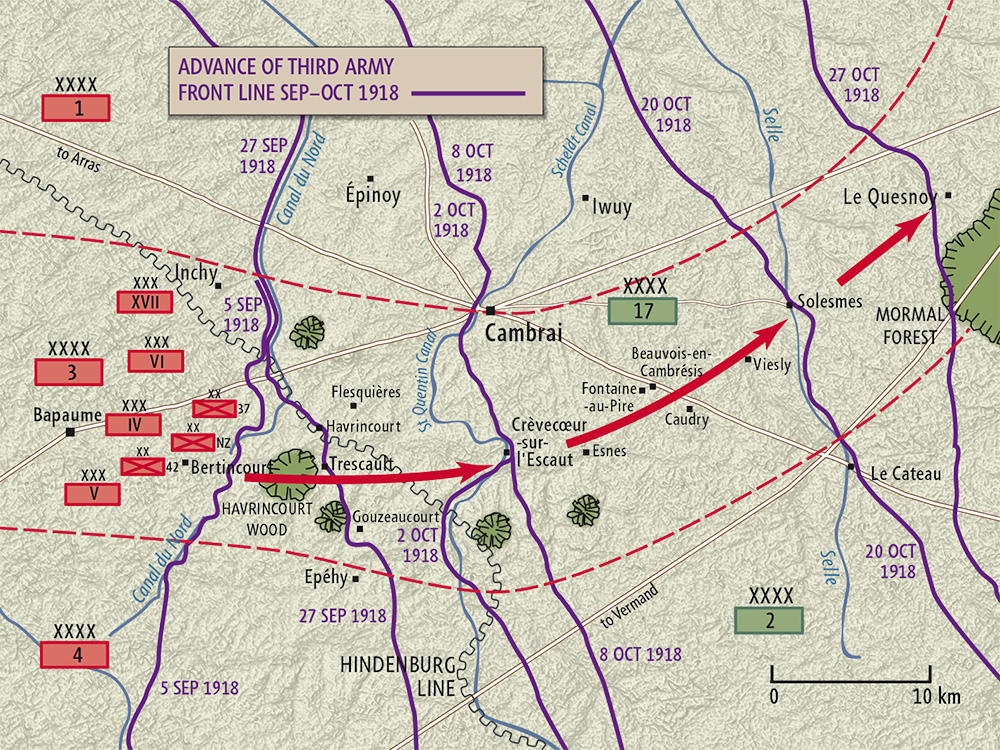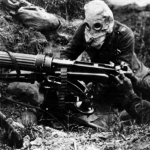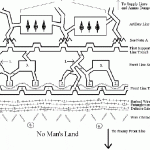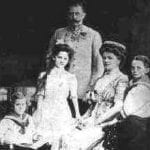After Germany’s’ failed spring offensive, realized the only way to win was to push into France before the United States fully deployed its resources. The French and British were barely hanging on in 1918. By 1918, French reserves of military-aged recruits were literally a state secret; there were so few of them still alive. The British, barely maintaining 62 divisions on the Western Front, planned, in the course of 1918 – had the Americans not appeared – to reduce their divisions to thirty or fewer and essentially to abandon the ground war in Europe. But with the Americans, it renewed the fighting chances for the Allies. They decisively overtook the Germans at the Meuse-Argonne Offensive in September. In November, Kaiser Wilhelm, visiting Spa, was advised that he had no real control over much of the army. While there, he received a telegram from Berlin that read “All troops deserted. Completely out of hand.” Wilhelm decided to go to the Netherlands. There, he abdicated on November 9. The war officially came to an end on November 11, where all troops kept a moment of silence.
It was a religious experience. Here’s what novelist Kurt Vonnegut says about it: “I have talked to old men who were on battlefields during that minute. They have told me in one way or another that the sudden silence was the Voice of God. So we still have among us some men who can remember when God spoke clearly to mankind.”
- The Battle of Amiens
- Generals Haig and Rawlinson wanted to conduct a series of smaller, surprise attacks on the Germans all up and down the front.
- At 4:20 AM on August 8, the British/Australian/Canadian force attacked and overran the German front line and advanced 10 miles by noon. Ludendorff called this “The Black Day of the German Army.”
- German forces retreated, refusing to obey orders to stand and fight. Many surrendered. Before long, however, they rallied and counterattacked.
- Ludendorff wrote “We cannot win this war any more, but we must not lose it.” He offered his resignation to Hindenburg, who rejected it.
- The battle ended on the 12th, when the British reached the German defenses.
- The Allies took 44,000 casualties. The Germans lost 70,000 casualties, plus 28,000 prisoners.
- Further Actions in Late August
- On August 20, the French attacked between Soissons and Compiegne, driving the Germans back. Ludendorff called this a second “black day for the German Army.”
- On the 21st, the British and New Zealanders, supported by 156 tanks, attacked the German lines, taking several thousand prisoners.
- The British and French also attacked along the Somme (Battle of Albert/Bapaume), taking all the positions they had fought over in 1916.
- On the 26th, the British captured Delvile Wood in the Battle of the Scarpe.
- On the 30th, the French pushed the Germans back across the River Aisne.
- That same day, the Americans captured Juvigny.
- In 11 days, the Allies captured 10 miles of ground. They also pushed the Germans back in Flanders.
- The Allied commanders planned further attacks in late September. The British would attack eastward against the center of the Hindenburg line, the French and Americans northward across the River Meuse, and the British and Belgians in Flanders.
- In late August, Ludendorff ordered the entire German line back to the Hindenburg Line. He thus opted for a purely defensive strategy.
- By the end of August, the Germans had taken 228,000 casualties (110,000 of whom had probably deserted). They only received 130,000 replacements.
- The Battle of St. Mihail
- This was the first battle planned and conducted by an American army with its own commander.
- The American First Army had thrown fake orders into a waste basket so that the Germans would find them. These orders said the attack would occur at Moulhouse (Martin Gilbert). But the real attack was to occur at St. Mihail.
- To prepare for the attack, 3000 big guns and 40,000 tons of ammunition were assembled. 15 miles of road were built using 100,000 tons of crushed stone. 250 miles of light gauge rail and 45 miles of standard gauge railways were built.
- On September 12, 200,000 Americans and 48,000 French attacked along a 12 mile front in the pouring rain. The Americans fired off thousands of shells of phosgene gas. The Allies had 1400 planes in the sky.
- The Allies had a 3-1 advantage in infantry and 5-1 in artillery, and 7-1 with aircraft. They also had nearly 300 tanks.
- The Germans quickly retreated. The Allies took 7000 casualties, while the Germans had 17,000 (13,000 of these were prisoners). The Allies took 200 square miles and several towns (including St. Mihail).
- The war had once again become a war of movement.
- Further Operations: September and October
- On September 18, the Allies overran the outer works of the Hindenburg Line.
- Since August 18, the British Army had advanced more than 25 miles on a front of 40 miles. (Compare this to the Somme in 1916, when the advanced less than 10 miles on a front of 20 miles in 4.5 months).
- On September 26, French and American forces attacked and drove the Germans back. Both armies advanced several miles. The American forces had the Argonne forest on their left.
- The same week, the British attacked the center of the Hindenburg line. The Germans fought this attack off.
- From July 15 to September 30, the Allies took nearly 250,000 prisoners on the Western Front alone.
- On September 28th, The British launched another offensive (called the 5th Battle of Ypres by some). With Belgian support, they pushed the Germans back until bad weather forced them to halt.
- Another attack on the 29th by Americans and Australians attacked across the ________ canal. This broke an 8 mile stretch of the second part of Hindenburg Line. Now only the German third line of defense remained intact.
- Over the next few days, the Allies continued pushing the Germans back.
- The Americans were stopped at the Argonne, largely due to logistical issues.
- Meuse-Argonne
- On September 28, Ludendorff told Hindenburg they had to seek an armistice. They both told the Kaiser this. But President Wilson refused to negotiate with the Kaiser. The Kaiser signed a proclamation establishing a parliamentary regime.
- Ludendorff stated “We cannot fight against the whole world.”
- In early October, Pershing decided not to attack the central position, but to instead focus on the heights of the Argonne and the Meuse (on the flanks). Slowly but surely, the Americans cleared the Argonne of Germans.
- In the Argonne, a former conscientious objector, Corporal Alvin York, and his men were given the task of clearing out a German machine gun nest. In their initial effort, 9 of his 17 men were wounded. York told the other 7 who were not wounded to guard prisoners. He went to the machine gun nest himself. He killed up to 28 Germans with his marksmanship. The Germans surrendered, and he returned to his men with 132 prisoners. He was promoted to sergeant and became an international celebrity.
- Also in the battle, a battalion of 500 Americans got cut off from the main force and became surrounded by Germans. They ran out of food and were hit by artillery (both German and American). They sent a carrier pigeon to the Americans, asking them to stop shelling. German flamethrowers attacked, but the Americans fought them off. The American high command thought the situation was hopeless and that the battalion was “lost.” The Germans withdrew on October 7, and the surviving members of the “Lost Battalion” rejoined the main American force.
- On the 14th, the Americans took the high ground. They had achieved their objectives set on September 26. They had one more German position to take.
- On November 6, the Americans began a new offensive at the Meuse River. They had three artillery batteries made from 14 inch naval guns. They also used 41 tons of mustard gas and many aircraft. They completely broke through the German lines. In the confusion of the battle, brigade commander General Douglas MacArthur was taken prisoner by American forces, who mistook him for a German general.
- Further Allied Advances and the Armistice
- Meanwhile, the Allies made gains at several places along the front. They overran the last part of the Hindenburg Line. The Germans retreated from the 9th to the 11th to the Hermann position. Their heavy artillery stopped the Allied advance.
- On the 14th, King Albert of Belgium led an attack on German forces in Flanders. He was supported by American bombers. In 4 days, they advanced nearly 20 miles, took 12,000 prisoners, and 550 big guns. The German navy retreated from Belgian ports, and the Allies nearly reached the Dutch border. By the 19th, the entire Belgian coast was in Allied hands.
- On the 17th, the Allies attacked the Hermann position. They were supported by 1300 heavy guns. The infantry attack pushed the Germans back.
- On October 26, Ludendorff was removed from his position as Quartermaster General. When his resignation was announced in movie houses, people cheered. Ludendorff, fearing for his safety, fled to Sweden in disguise.
- On November 4 and 5, British and French forces made further gains.
- Despite the Allies’ successes, they took large numbers of casualties.
- As the German navy went into mutiny and unrest broke out across Germany, a German delegation met with Foch and other Allied leaders in Compiegne on the 9th. Early on the 11th, they agreed to an armistice that would go into effect at 11:00 on that day.
- Kaiser Wilhelm, visiting Spa, was advised that he had no real control over much of the army. While there, he received a telegram from Berlin that read “All troops deserted. Completely out of hand.” Wilhelm decided to go to the Netherlands. There, he abdicated on November 9.
- At 11 AM, there was silence, followed by the roar of men cheering. The fighting was over.
Cite This Article
"The Hundred Day’s Offensives and The End of WW1" History on the Net© 2000-2024, Salem Media.
July 27, 2024 <https://www.historyonthenet.com/the-hundred-days-offensives-and-the-end-of-ww1>
More Citation Information.









